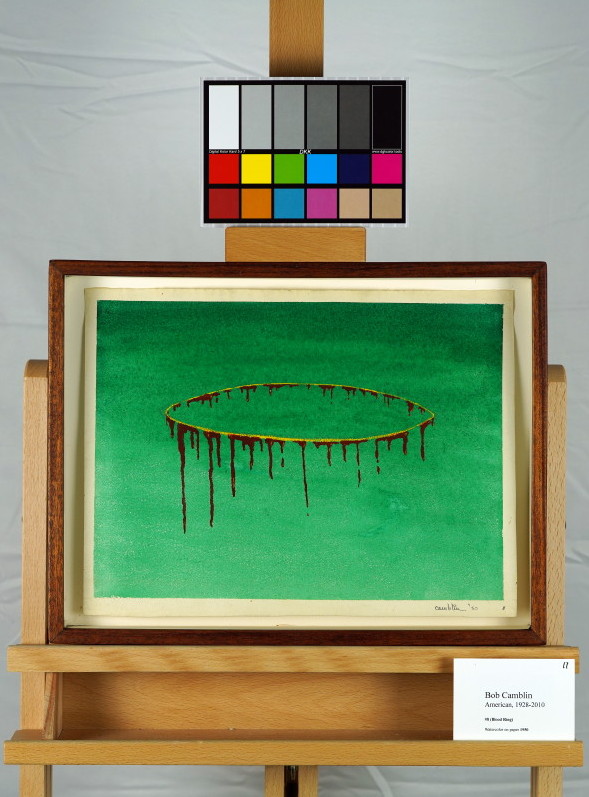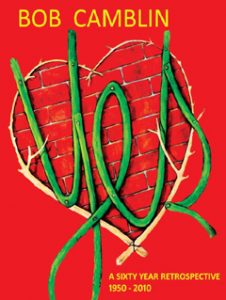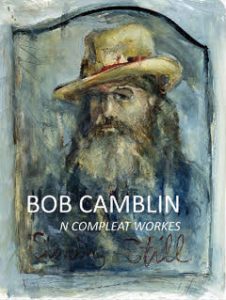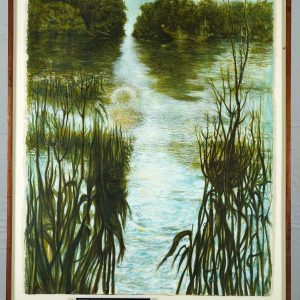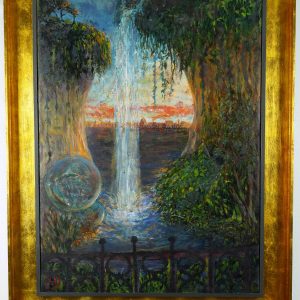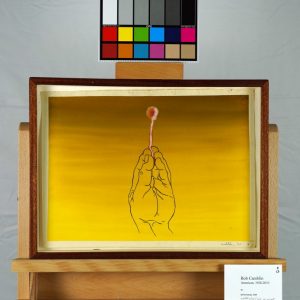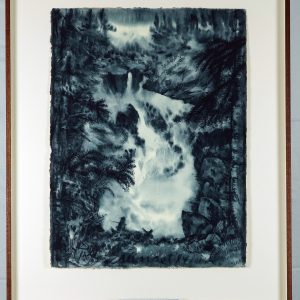Description
# 8 Blood Ring, 1950Watercolor on paper
Signed
10 x 13.75 in. (image)
13 x 16.5 x 2.0 in. (frame)
original, includes certificate of authenticity from ArtTrust
Let’s dive into the interpretation of this evocative image called (#8) featuring a suspended circular form that drips with red, resembling blood, against a turquoise background. This painting invites a rich analysis, combining Zen philosophy, the I Ching, and broader art history perspectives:
In Zen Buddhism, the circle, or ensō, is a sacred symbol representing enlightenment, the universe, and the void. The dripping circle here subverts the traditional completeness associated with the ensō. Instead of pure wholeness, it hints at impermanence and suffering, suggesting the cycle of birth, decay, and rebirth. The drips may symbolize the karmic consequences of actions, constantly flowing and never static. The Zen lesson here could be about accepting the fluidity of existence and the unavoidable aspects of suffering, while finding liberation in understanding and embracing this reality.
The I Ching, or Book of Changes, speaks of the natural cycles and transformation processes that govern life. The dripping form could be interpreted in relation to Hexagram 23 (Po), which signifies “Splitting Apart.” This hexagram warns of decay and suggests that sometimes things must deteriorate before renewal can occur. The dripping effect evokes the image of something gradually losing its form, yet in alignment with the principle of constant change, suggesting a slow transition towards something new.
Combining these perspectives, the artwork embodies the idea of transient existence—a circular form representing unity or wholeness, which is being eroded by time. The red drips serve as a stark reminder of life’s fragility, as well as the sacrifices that might be needed for true enlightenment or transformation. The background’s calm turquoise hue juxtaposed with the visceral quality of the drips, creating a tension that reflects the contrast between inner peace and worldly suffering.
Historically, the use of circular forms in art has often been associated with sacred geometry, mandalas, and other spiritual symbolism. The artist’s choice to add a bleeding effect gives a modern existential twist to these traditions, bridging the spiritual with the rawness of contemporary concerns about life, death, and the human condition. This subversion aligns the piece with modern and postmodern tendencies to question traditional forms and symbols.
Together, these interpretations converge to create a complex, multilayered understanding of the painting—one that urges viewers to confront the beauty and tragedy of life, the inevitability of change, and the possibility of finding transcendence within impermanence.
*Shipping cost will vary, please inquire at sales@camblingallery.com before purchasing.
Currently ships from Oregon, USA
Member of artnet? Apply for a discount! Inquire about intergallery and permanent loans for museums.
“#8 Blood Ring” was featured in his Yes Retrospective and in volume I of the series Bob Camblin N Compleat Workes.
Reproductions of this drawing are available in multiple sizes!
Click here to use our high-resolution viewer!
This artwork is available with a non-fungible token to ensure traceability and transparency of provenance.
The royalty factor – Unlike traditional artworks, such as paintings, mosaics, statues, and the like, NFTs can be programmed to provide royalties to you every time the painting (and token) is sold and resold – for eternity. That mind-bending Camblin you sold could be worth millions one day and provide income for your great-great-great grandkids!
Anti-forgery – The central idea underpinning NFTs is that they are built on the blockchain, which is meant to offer advanced security. Think of it like an un-erasable and un-avoidable copyright.
Easy authentication – Another compelling aspect of NFT art and NFTs in general is the ability to quickly and easily authenticate items, as the record of ownership is scrupulously kept on the blockchain.
